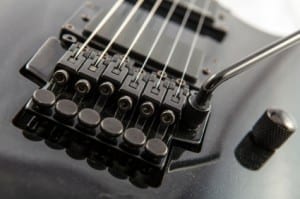When you’re getting ready to record an electric guitar track, the pickups of the guitar may not be the most immediate thing on your mind. No, first you've got to decide which microphone you will use, which amp you will run the guitar through, and which guitar you want to use.

But for that last consideration, you may want to think about your goals for the track, and what kind of sound you are going to get with the guitar that you think you want to use. Though it can be a hard thing for a guitarist to admit, sometimes their favorite axe is just not the best for the particular job at hand. This is particularly true when you are recording a track that may not be the primary electric guitar on the song, but rather is used to fill out a sound or add layers.
We suggest that in cases like this you may want to consider what pickups on the guitars you have available. There are essentially two kinds of pickups used today: single coils and humbuckers. But each can have a few different types, which we’ll explore further here.
This article is designed as a basic overview of general pickups. In part two of this series, we’ll delve into a more advanced lesson on pickups.
These were among the first electric pickups, and were installed on the Fender Telecaster when it became the first electric guitar to be mass produced. And two single coil pickups are still installed on the standard Telecasters that are produced to this day.
Most popular electric guitar pickups are magnetic pickups, and consist of a coil of wire that is wrapped around a bobbin thousands of times. As the name might imply, a single coil pickup has one of these bobbins that the wire is wrapped around.
As for sound, single pickups are bright, and offer great note definition. That’s why guitars like Telecasters were so popular on country songs when they were first developed. Among many other uses, these can be a great addition to provide sharper notes on a song that otherwise has a ton of warm, fat guitar sounds (provided the song calls for it, of course).
The downside, however, is this type of pickup is prone to produce extraneous noise caused by magnetic interference.
It was that susceptibility to noise that (in part) led to the development of the humbucker pickup in 1955 by a Gibson engineer. The idea is simple: wire together two single coils pickups, arranged with their magnetic poles opposite each other. This would eliminate noise caused by magnetic interference. Because of the nature of how the pickups were constructed, they are louder (often referred to as “hotter”) than single coil models, and also create a warmer tone.
Another type of pickup you may hear a lot about is the P-90 pickup, though this is actually a specific type of single coil pickup. These models also were developed by Gibson, and were the primary models used by the company until the humbucker came along.
As opposed to the Fender single coil construction, P-90s are larger and more complex, and therefore produce a warmer sound. Since this sound essentially falls between a traditional single coil and a humbucker, they have stuck around all these years and are still installed on numerous guitars.
Finally, it should be noted that some pickups can function both as single coil models and as humbuckers. Essentially, these are built as humbucker pickups, but include a switch that changes them to single coils.
This should give you a good idea of each type of pickups that are available, and what kind of sound they can give you on your recordings. Be sure to check out part two of the guitar pickups in the recording studio series for a more in-depth look at each type of pickup.
There are 8 unique value-points inside the Sage Audio membership, so let’s go over each one so you can decide if it’s the right fit for you.
1. 50 Free Mastered Songs Per Year
2. 1-on-1 Mentorship
3. Unlimited Mixing Feedback
4. Sage Audio University™ (SAU) — (Mixing and Mastering Education Platform)
5. Mixing and Mastering Competitions
6. Community
7. 70+ GB of Curated Sage Audio Downloadable Content, Including:
8. 700+ Video Catalog